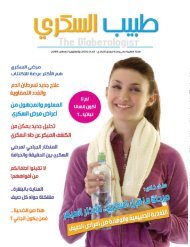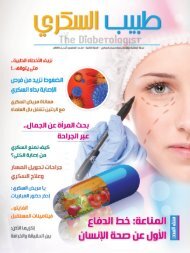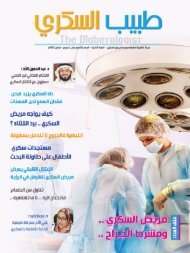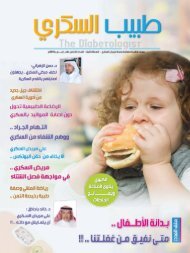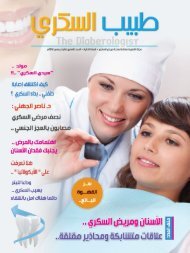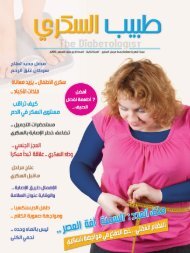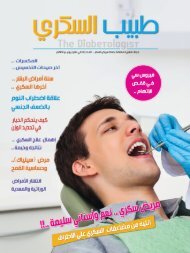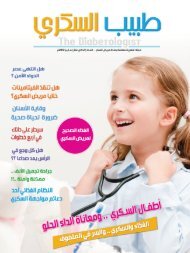The Diabetologist #26
طبيب السكري - العدد 26
طبيب السكري - العدد 26
You also want an ePaper? Increase the reach of your titles
YUMPU automatically turns print PDFs into web optimized ePapers that Google loves.
Even though IL-1 blockade was not effective in newonset<br />
T1D (see Preservation section), use earlier in<br />
the course of the autoimmune process may prove effective.<br />
<strong>The</strong>re is also interest in non-steroidal anti-inflammatories<br />
and further assessment of omega-3 fatty<br />
acids, possibly in combination with vitamin D. Nonspecific<br />
immunostimulants, such as OM85 and BCG,<br />
could also prove effective. Emerging evidence links the<br />
intestinal micro-biome with mucosal immunity and T1D<br />
risk. Probiotics, helminthes (such as trichuris suis ova),<br />
and even lactobacillus modified to over-express IL-10<br />
may alter T1D risk.23 As noted with antigen-based<br />
therapies, optimizing dose, frequency, and timing of<br />
administration in the disease course will be necessary<br />
for success. It may be that a combination of drugs<br />
working by different mechanisms is necessary to accomplish<br />
the task. Investigators will continue to closely<br />
monitor advances in related autoimmune diseases and<br />
transplantation, in search of therapies that warrant assessment<br />
in T1D prevention.<br />
.III PRESERVATION<br />
Preservation trials focus on halting further pancreatic<br />
beta-cell destruction after T1D diagnosis. At the time of<br />
diagnosis, it has been estimated that 15–40% of betacell<br />
function remains. However, this remnant can serve<br />
one well while it lasts, as evidenced by better overall<br />
glycemic control during this remission or honey-moon<br />
phase, with lower A1Cs, less glycemic variability, and<br />
less hypoglycemia risk. For several decades, investigators<br />
have attempted to define a safe and effective<br />
means to preserve beta-cell function following diagnosis.<br />
However, intervening late in the process poses the<br />
challenge of daring to be aggressive enough to arrest<br />
further destruction while finding an intervention that<br />
is safe and tolerable. In those with long-standing disease,<br />
such therapy could be used in conjunction with<br />
a beta-cell replacement strategy: even if replacement<br />
islets are generated from host stem cells, one must<br />
control the chronic autoimmune response to enable<br />
long-term cell survival. Over the past few decades, numerous<br />
agents have been evaluated with varying levels<br />
of success, with many efforts conducted with smaller<br />
number of subjects and often lacking a contemporaneous<br />
control group. A subset of these efforts is reviewed<br />
herein, with a focus on the well-powered randomized,<br />
placebo-controlled studies.<br />
Antigen-Based <strong>The</strong>rapies<br />
Antigen-based therapies have yielded disappointing<br />
results in new-onset T1D patients. Given its known<br />
role as a primary antigen in the NOD mouse and in<br />
humans, it is not surprising that various forms of insulin<br />
as an antigen- based therapy have been attempted<br />
in new-onset T1D studies. While some have shown<br />
early promise after disease onset, no large, placebocontrolled<br />
study has shown efficacy to date (reviewed<br />
in Prevention section). Animal studies and pilot human<br />
clinical studies with glutamate decarboxylase (GAD)<br />
were promising, but subsequent phase II and III trials<br />
have shown no effect.24,25 As with the insulin antigen<br />
experience, there may be numerous reasons for<br />
the negative findings to date and opportunities to optimize<br />
responses. <strong>The</strong>se include 1) antigen use earlier<br />
in the course of disease (as a preventive measure), 2)<br />
use of specific peptides vs. whole molecules, 3) an<br />
alternate dose or frequency of antigen administration,<br />
4) an alternate route of administration, or 5) use<br />
of an alternate adjuvant to improve efficacy.<br />
,Diapep277 an epitope of heat shock protein 60, is<br />
another antigen that may be involved in autoimmune<br />
responses against the beta-cell, though it does not<br />
appear to be one of the primary initial targets. Phase<br />
II trials showed mixed results with statistically significant<br />
preservation of -1-cell function in adults but not<br />
in children, and there was no change in A1C and insulin<br />
requirements.26 Results from a recently completed<br />
randomized, double-blind, phase III trial for adults<br />
with new-onset T1D reached the primary outcome,<br />
showing modest improvement in glucagon stimulated<br />
C-peptide at 24 months for the treated group, with improvement<br />
in some secondary measures of metabolic<br />
control (A1C, insulin use, hypoglycemia frequency),<br />
yet there was no difference in stimulated C-peptide on<br />
MMTT between the two groups (NCT01103284).27 A<br />
follow-up phase III trial will soon be underway to confirm<br />
these findings. None of the Diapep277 trials has<br />
raised any safety concerns.<br />
Anti-Inflammatory Agents<br />
Beta-Cell destruction may result from inflammation as<br />
well as autoimmunity, and thus another approach to<br />
preserving beta-cell function is through use of antiinflammatory<br />
agents. Recent focus has centered on<br />
responses generated by the innate immune system,<br />
and IL-1 has been implicated as a primary proinflammatory<br />
cytokine and mediator of beta-cell destruction.<br />
A TrialNet-sponsored phase II new-onset T1D clinical<br />
trial with the IL-1beta receptor antagonist canakinumab<br />
failed to demonstrate efficacy in the initial analysis<br />
of the primary end point at 1 year (NCT00947427)<br />
(Moran, submitted manuscript).28 Similarly, a phase II/<br />
III study with the IL-1 receptor antagonist anakinra also<br />
failed to reach the primary end point (NCT00711503)<br />
(Mandrup-Poulsen, TR, submitted manuscript). As<br />
with other therapies, it may be that dosing earlier in<br />
issue 26 < November. 2013<br />
03





